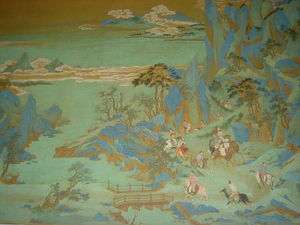Blue-green shan shui
The blue-green shan shui (simplified Chinese: 青绿山水; traditional Chinese: 青綠山水; pinyin: Qīng-Lǜ Shān-Shuǐ), is a Chinese painting style of "Shan shui". It tends to refer to an "ancient style" rather than modern ones. The main colours of the paintings are blues and greens, and in the early period it was painted using mineral dyes. It's said this style was first formulated by Li Sixun (simplified Chinese: 李思训; traditional Chinese: 李思訓; pinyin: Lǐ Sī-Xùn),[1] a general, politician and famous painter in Tang Dynasty.[2]
History and sub-styles

Similar styles appeared before the Tang Dynasty, especially in the period of the Six Dynasties.[2] Many historic records show that Li father and sons – Li Sixun (father) and Li Zhaodao (son, Chinese: 李昭道; pinyin: Lǐ Zhāo-Dào, son of Li Sixun), largely developed the painting techniques and formulated the style.[1]
There are mainly two styles of this painting:[2]
- Shibi Qingyuan (simplified Chinese: 式笔青綠; traditional Chinese: 式筆青綠; pinyin: Shì-Bǐ Qīng-Lǜ)
- Yibi Qingyuan (Chinese: 意笔青綠; pinyin: Yì-bǐ Qīng-Lǜ)
Schools
- General blue-green shan shui.
Late Northern Song Dynasty:
- Bright green shan shui (Chinese: 金碧山水; pinyin: Jīn-Bì Shān-Shuǐ)
- Great blue-green shan shui (simplified Chinese: 大青绿山水; traditional Chinese: 大青綠山水; pinyin: Dà Qīng-Lǜ Shān-Shuǐ)
- Little blue-green shan shui (simplified Chinese: 小青绿山水; traditional Chinese: 小青綠山水; pinyin: Xiǎo Qīng-Lǜ Shān-Shuǐ)
Yuan Dynasty, Ming Dynasty and Qing Dynasty:
- The little blue-green shan shui is the dominant style/school. Especially in the Late Ming Dynasty, the painter Lan Ying (Chinese: 蓝瑛; Pinyin: Lán Yīng) from Zhe School (Chinese: 浙派) developed the style to an historic climax.[2][3]
Quotations
ZHANG Geng (simplified Chinese: 张庚; traditional Chinese: 張庚; pinyin: Zhāng Gēng) in Qing Dynasty, said:
| “ | 畫,繪事也,古來無不設色,且多青綠。(simplified Chinese: “画,绘事也,古来无不设色,且多青绿”. English translation: Painting, drawing events, in ancient time was all in colour, mostly in blue and green) | ” |
TANG Hou (simplified Chinese: 汤垕; traditional Chinese: 湯垕; pinyin: Tāng Hòu) in Yuan Dynasty, said:
| “ | 李思訓著色山水,用金碧輝映,自爲一家法。(simplified Chinese: “李思训著色山水,用金碧辉映,自为一家法”. English translation: Li Sixun painted shan shui in colour, using bright shining blue and green, developed his own techniques and formed his own school.) | ” |
See also
References
- 1 2 "李思训 (Li Sixun (Tang Dynasty general, politician and painter))" (in Chinese). Baidu.com Chinese Encyclopedia. Retrieved January 1, 2010.
- 1 2 3 4 "青绿山水 (Blue-green Shan Shui)" (in Chinese). Baidu.com Chinese Encyclopedia. Retrieved January 1, 2010.
- ↑ "蓝瑛 (Lan Ying (painter))" (in Chinese). Baidu.com Chinese Encyclopedia. Retrieved January 1, 2010.